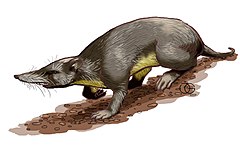Nesophontes
| Nesophontes[1] Temporal range: Holocene
| |
|---|---|

| |
| Nesophontes edithae | |
| Scientific classification | |
| Kingdom: | |
| Phylum: | |
| Class: | |
| Order: | |
| Family: | †Nesophontidae Anthony, 1916
|
| Genus: | †Nesophontes Anthony, 1916
|
| Species | |
|
†Nesophontes edithae | |
Nesophontes, sometimes called West Indies shrews, is the sole genus of the extinct, monotypic mammal family Nesophontidae in the order Eulipotyphla. These animals were small insectivores, about 5 to 15 cm long, with a long slender snout and head and a long tail. They were endemic to Cuba, Hispaniola (Dominican Republic and Haiti), Puerto Rico, the United States Virgin Islands, and the Cayman Islands.
Although reliable estimates are unavailable, these animals are widely believed to have survived the Pleistocene extinction since remains have been found among those of Rattus and Mus species. Some authorities estimate extinction coinciding with the arrivals of rats aboard Spanish vessels in the early 16th century (1500). Others, such as Morgan and Woods, claim that some species survived until the early 20th century.[2] A phylogenetic study in 2016, based on DNA extracted from a specimen about 750 years old, suggests their nearest relatives are the solenodons, although the two groups diverged more than 40 million years ago.[3]
The West Indies shrews have only been described from fossil records and skeletal material in owl pellets found in the Greater Antilles and surrounding islands. Recent efforts to locate surviving populations have been unsuccessful.[4] Although some Nesophontes remains (in owl pellets) have been reported as fresh-appearing, radiocarbon dating has failed to support any post-15th century dates, suggesting that the nesophontids became extinct very rapidly at approximately the time of European discovery of the Greater Antilles.[5]
Since Nesophontes species have only been observed through fossil records the exact number of species varies among authorities. Some claim as many as 12 valid species while other claim as few as six.[1]
- Puerto Rican nesophontes (Nesophontes edithae)
- Atalaye nesophontes (Nesophontes hypomicrus)
- Slender Cuban nesophontes (Nesophontes longirostris)
- Greater Cuban nesophontes (Nesophontes major)
- Western Cuban nesophontes (Nesophontes micrus)
- St. Michel nesophontes (Nesophontes paramicrus)
- Lesser Cuban nesophontes (Nesophontes submicrus)
- Cuban nesophontes (Nesophontes superstes)
- Haitian nesophontes (Nesophontes zamicrus)
Two other species from the Cayman Islands remain undescribed.[6]
See also
References
- ^ a b Hutterer, R. (2005). "Order Soricomorpha". In Wilson, D.E.; Reeder, D.M (eds.). Mammal Species of the World: A Taxonomic and Geographic Reference (3rd ed.). Johns Hopkins University Press. pp. 220–222. ISBN 978-0-8018-8221-0. OCLC 62265494.
- ^ Morgan, G. S.; C. A. Woods (1986). "Extinction and the zoogeography of West Indian land mammals". Biological Journal of the Linnean Society. 28: 167–203. doi:10.1111/j.1095-8312.1986.tb01753.x.
{{cite journal}}: Unknown parameter|lastauthoramp=ignored (|name-list-style=suggested) (help) - ^ Brace, Selina; Thomas, Jessica A.; Dalén, Love; Burger, Joachim; MacPhee, Ross D.E.; Barnes, Ian; Turvey, Samuel T. (13 September 2016). "Evolutionary history of the Nesophontidae, the last unplaced Recent mammal family". Molecular Biology and Evolution (Epub ahead of print). 33 (12): 3095–3103. doi:10.1093/molbev/msw186. PMID 27624716.
{{citation}}: Unknown parameter|lastauthoramp=ignored (|name-list-style=suggested) (help) - ^ Woods, C. A., J. A. Ottenwalder, and W. L. R. Oliver (1985). "Lost mammals of the Greater Antilles: summarized findings of a ten week field survey in the Dominican Republic, Haiti and Puerto Rico". Dodo (Jersey Wildlife Preservation Trust). 22: 23–42.
{{cite journal}}: CS1 maint: multiple names: authors list (link) - ^ MacPhee, R. D. E., C. Flemming, D. P. Lunde (1999). ""Last occurrence" of the Antillean insectivoran Nesophontes : new radiometric dates and their interpretation". American Museum of Natural History "Novitates" (3261). hdl:2246/3106.
{{cite journal}}: CS1 maint: multiple names: authors list (link) - ^ Morgan, G.S. 1994. Late Quaternary fossil vertebrates from the Cayman Islands. Pp. 465–508 in Brunt, M.A. and Davies, J.E. (eds.). The Cayman Islands: Natural History and Biogeography. Springer, 604 pp. ISBN 978-0-7923-2462-1
